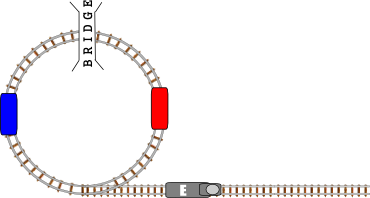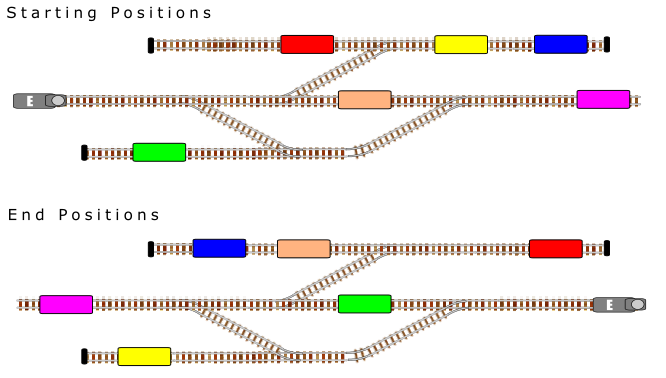A selection of classic shunting puzzles to amuze and entertain you.

A selection of classic shunting puzzles to amuze and entertain you.
Two trains are travelling along the same stretch of single line track towards each other. Each train consists of an engine and two coaches. There is however a siding that can take one engine and one coach. How is it possible for the two trains to pass each other by using this siding?

This problem is presented as January 9th's Starter of The Day and you are invited to work on it using plastic cubes and these printable train tracks. The solution is also available from that Starter of the Day page.
This shunting puzzle involves a circular track at the end of the main line. There are two trucks and an engine. The objective is the use the engive to change the position of the two trucks and for the engine then to return to the main line. The problem is that there is a low bridge which the engine can pass under but the two trucks can not.

I first came across this puzzle back in the 1960s when I was a pupil at D'Eyncourt County Primary school. It was presented to the class as an optional homework challenge and I remember the thrill going to school the following day knowing I had solved it.

The objective is to use the engine to swap the positions of the two trucks and return it to its starting position. I can't remember which of the versions above we worked on but I seem to remember that the section of track at the top of the first diagram is only long enough for one truck and the section of track to the left of the points in the second diagram is also too short for the engine.
Another classic shunting puzzle based on the real Kilham Sidings on the Alnwick-Cornhill branch of the North Eastern Railway (NER).

There are three short tracks connevted to the main line. The trach at the top of the diagram can hold five trucks while the other two sections can hold three each. A numner of trucks is selected from the eight available and the engine has to shunt the trucks in such a way that the selected trucks, in order, are coupled behind the engine for a journey on the main line.
Probably the most famous shunting puzzle is Timesaver was first published in the November 1972 issue of Model Railroader. The first diagram shows the sidings connected to the main line and indicated the maximum number of trucks that can be in any section of the sidings.

The diagram below is one of many possible challenges and, as the title suggests, the objective is to move the trucks in the least amount of time.

You are now invited to try our tram shunting puzzles. They are interactive and you can earn a virtual Transum Trophy for each puzzle you complete.
And for the expert shunter here is a Bonus Level to finish your shunting day!.
Do you have any comments? It is always useful to receive feedback and helps make this free resource even more useful for those learning Mathematics anywhere in the world. Click here to enter your comments.
Matthew Scroggs, Twitter
Wednesday, May 22, 2019
Matthew Scroggs, Twitter
Wednesday, May 22, 2019
ClimberT8, Personal
Tuesday, January 25, 2022
"For the Timesaver puzzle shown on the Shunting Puzzles page, what are the starting and ending positions of the engine?
[Transum: That's a very good question ClimberT8. I have always assumed that the engine came into the sidings from the main line. I have added images of the engine to show that. I hope that is what the creator of this puzzle (John Allen) intended.]"